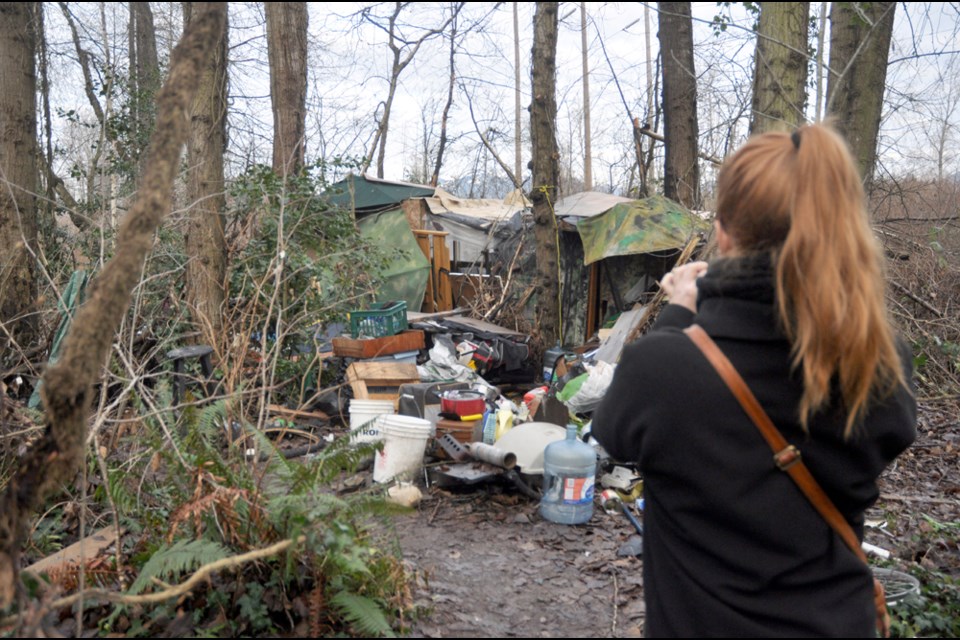Living in the bush has its hazards. A couple of years ago, John was sleeping in his shack when he felt something warm on his foot, warm enough to stir him from sleep. A burning candle had started a fire and spread through his home as he slept.
“I was sitting there in my underwear, (I) jumped out of bed, I looked around, threw some clothes out the door, and luck would have it, I found a matching pair of shoes,” he recalls.
John, who prefers we don’t use his last name, tried to put out the fire, but his water supply was frozen, so there wasn’t much he could do.
John stayed at a friend’s house, but when he returned, his entire home burned down.
John’s not the only one. In February last year, a man ran out on to Lougheed Highway, after his tent caught fire, and he was taken to hospital in critical condition. Last November, another camp caught fire on the side of Lougheed, but when firefighters arrived, there was no one on site.
John didn’t stick around to wait for fire trucks to show up when his place burned down.
“I didn’t really feel like watching it burn, and I wasn’t really quite sure of any potential consequences for me, so there was no point in hanging around,” he says.
It’s a short stretch through tangled brush and trees to John’s place, a homemade shack in the woods, not far from Burnaby’s Still Creek. John is one of Burnaby’s 60 or so homeless. He wears jeans and a matching denim jacket with work boots and has long, dark hair. His home includes a bed with a frame he built himself, a stove, several paintings and a cat named Spunky, and a “neighbour” camping out in the same stretch of brush.
“It’s not exactly outdoors,” John says. “I’m indoors. I have a queen-sized bed. It’s a little unconventional perhaps, but I mean it kind of looks worse than it is. My neighbour keeps telling me to clean up. I guess I should probably do that one of these days.”
According to the last Homeless Count in 2013, Burnaby only has 58 people living outdoors, in shelters or couch surfing – down from 78 in the previous count. The next count is in 2017.
John seems content, all things considered. He can cook for himself, and if he gets cold, he uses his stove to keep warm. He buys food with what little money he has – he receives some kind of emergency funds from the government, but that’s running out unless he applies for disability. He also says he gets some money from selling his paintings.
“Rent’s got too ridiculous,” he says, “and the places you can afford are not really that desirable.”
John’s not too concerned about the lack of a permanent, year-round homeless shelter in Burnaby. He wouldn’t use it anyway.
“I don’t like shelters,” he said. “Who would? Why the hell would you want to be told when to get up, when to eat, when to go to sleep?”
Wanda Mulholland of the Burnaby Task Force on Homelessness says there are challenges with people who have been homeless for a very long time.
“But there are many examples of people who have found housing that they’re able to work with,” she said. “Shelter is only one of the housing options. The need is not only for shelter, it is for a wide continuum of housing options. Shelter is only one of those.”
Everybody’s different in terms of what would work for them, she adds.
Some people prefer housing in a non-profit run building with supports on site, others may prefer a shelter or their own apartment with rental subsidies.
“People have been very creative in establishing camps for themselves in the woods, and those camps can become problematic if there’s a fire or it’s extremely cold, and it’s quite possible people could live very comfortably without infringing on anybody for a very long time,” she says. “Housing is very expensive. People do what they need to support themselves to live and to find housing that will work for them. People are very creative about it.”



